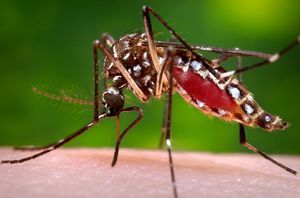Overview

Figure 1. Photo of a female Aedes Aegypti, the most common vector of the Yellow Fever Virus. Photo taken by James Gathany for the CDC's Public Health Image Library
By Christopher Kei Helm
Yellow fever is a human disease caused by the yellow fever virus, prevalent mostly in tropical climates. The yellow fever virus is a part of a family of viruses known as the Flavivirdae and the genus Flavivirus that fall under a broader category of arboviruses, or “arthropod-borne” viruses. In this case, most common arthropod vector of YF is the Aedes aegypti mosquito.
As stated previously, the disease is usually only prevalent in tropical regions of the world, mostly South America and parts of Africa (see figure 1). Even with vaccines available, yellow fever (YF) still causes 30,000 deaths annually with almost 200,000 cases occurring in Africa. Moreover, YF is an acute infection, with mortality rates ranging from 25~50%. Even worse, the number of cases of YF has increased in the past 20 years as a result of declining immunity among susceptible populations to infection, climate change, and urbanization. Because of this, YF is a critical public health issue in South America and Africa.

Figure 2. Map depicting geographic high risk areas for Yellow Fever, published by the WHO, July 2013.

Figure 3. Diagram of a Flaviviridae virion. Note the three types of proteins composing the virion's membrane (E, M, C). Also notice the herringbone-like arrangements the E proteins form on the right hand diagram. Figure is the property of the SIB Swiss Institute of Bioinformatics

Figure 4. Diagram of the Flavivirus' life cycle. Notice the initial binding to the host cell and the clathrin mediated endocytosis that follows the initial binding. Then the viral membrane fuses with the host's endosome to expose the viral ssRNA to the endoplasmic reticulum (ER). There, the ssRNA is transcribed and copied to make new viral proteins and new ssRNA. The viral particles are assembled and form a immature virion by budding off of the ER. After budding off, the immature virion moves to the Golgi. Moving from the Golgi to the host's membrane, the cell undergoes cleavages that cleave the prM protein into M proteins, maturing the virion before being secreted out of the host cell. Additionally, notice how the immature virion has a rough, spiked surface in contrast to the smooth surface of the mature virion. Diagram by Ted C. Pierson, NIH National Institute of Allergy and Infectious Diseases
Section 1
Include some current research, with at least one figure showing data.




